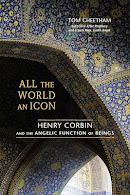"...the Imagination (or love, or sympathy, or any other sentiment) induces knowledge, and knowledge of an 'object' which is proper to it..."
Henry Corbin (1903-1978) was a scholar, philosopher and theologian. He was a champion of the transformative power of the Imagination and of the transcendent reality of the individual in a world threatened by totalitarianisms of all kinds. One of the 20th century’s most prolific scholars of Islamic mysticism, Corbin was Professor of Islam & Islamic Philosophy at the Sorbonne in Paris and at the University of Teheran. He was a major figure at the Eranos Conferences in Switzerland. He introduced the concept of the mundus imaginalis into contemporary thought. His work has provided a foundation for archetypal psychology as developed by James Hillman and influenced countless poets and artists worldwide. But Corbin’s central project was to provide a framework for understanding the unity of the religions of the Book: Judaism, Christianity and Islam. His great work Alone with the Alone: Creative Imagination in the Sufism of Ibn ‘Arabi is a classic initiatory text of visionary spirituality that transcends the tragic divisions among the three great monotheisms. Corbin’s life was devoted to the struggle to free the religious imagination from fundamentalisms of every kind. His work marks a watershed in our understanding of the religions of the West and makes a profound contribution to the study of the place of the imagination in human life.Search The Legacy of Henry Corbin: Over 800 Posts
Monday, January 5, 2015
A New Post from Ismaili Gnosis
with multiple excerpts from Corbin's Temple & Contemplation:

"Consider the cubic form of the Temple, which totalizes and interconnects spiritual and material realities, as a unique Emanation proceeding from the supreme Principle; that is to say, as a human person, as the Anthropos who is God’s Vicar with regard to what he envelops and contains eminently within himself. In other words, the figuration of the Temple of the Ka‘bah is likewise the figuration of Shiite prophetology and Imamology, because in both cases the same functional relationships are preserved."
Henry Corbin,
(Temple and Contemplation, 219)
Friday, January 2, 2015
Subscribe to:
Posts (Atom)
2014%20by%20Star%20Black05.jpg)





